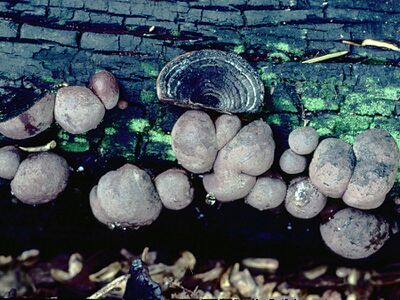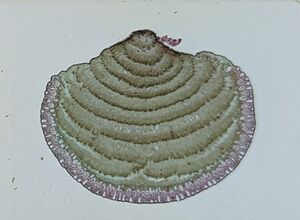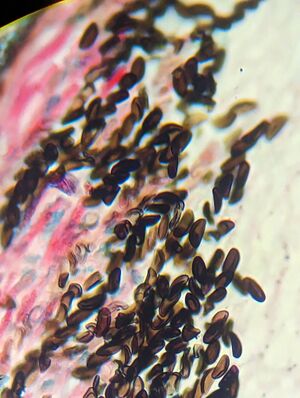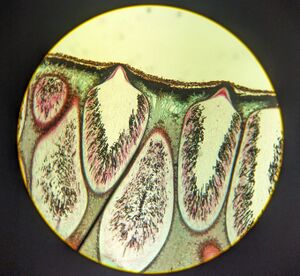User:Anaandrade: Difference between revisions
Anaandrade (talk | contribs) No edit summary |
Anaandrade (talk | contribs) No edit summary |
||
| Line 6: | Line 6: | ||
<i>Daldinia</i> is a genus of endophytic fungal species from the family <i>Hypoxylaceae</i> in the order <i>Xylariales</i>. The genus is named in 1863 by the Italian mycologists Cesati & De Notaris, after Agostino Daldini (1817-1895), a Swiss monk, clergyman and botanist. It is known by several common names such as <b>cramp balls</b>, <b>coal fungus</b>, and <b>King Alfred’s cake</b>. | <i>Daldinia</i> is a genus of endophytic fungal species from the family <i>Hypoxylaceae</i> in the order <i>Xylariales</i>. The genus is named in 1863 by the Italian mycologists Cesati & De Notaris, after Agostino Daldini (1817-1895), a Swiss monk, clergyman and botanist. It is known by several common names such as <b>cramp balls</b>, <b>coal fungus</b>, and <b>King Alfred’s cake</b>. | ||
==Morphology== | ==Morphology== | ||
[[Image:Daldinia perithecium.jpg|thumb|300px|right| | [[Image:Daldinia perithecium.jpg|thumb|300px|right|Microscopic slide depicting a section of a <i>Daldinia</i> perithecium. Photo by Ana Andrade, University of Arizona.]] | ||
In the introduction, briefly describe the habitat that is the topic of this page. Introduce the habitat, its ecological significance, and the importance of microorganisms in this environment. (What processes do they carry out? What functions do they perform?) | In the introduction, briefly describe the habitat that is the topic of this page. Introduce the habitat, its ecological significance, and the importance of microorganisms in this environment. (What processes do they carry out? What functions do they perform?) | ||
| Line 44: | Line 42: | ||
==Current and Future Research Applications== | ==Current and Future Research Applications== | ||
===Uses=== | |||
===Biofuels=== | ===Biofuels=== | ||
Revision as of 19:17, 11 December 2023
Daldinia
Daldinia is a genus of endophytic fungal species from the family Hypoxylaceae in the order Xylariales. The genus is named in 1863 by the Italian mycologists Cesati & De Notaris, after Agostino Daldini (1817-1895), a Swiss monk, clergyman and botanist. It is known by several common names such as cramp balls, coal fungus, and King Alfred’s cake.
Morphology
In the introduction, briefly describe the habitat that is the topic of this page. Introduce the habitat, its ecological significance, and the importance of microorganisms in this environment. (What processes do they carry out? What functions do they perform?)
Describe the physical and chemical characteristics of the environment, using as many sections/subsections as you require. If it is appropriate, you can divide the physical and chemical attributes of the environment into separate sections. Look at other topics available in MicrobeWiki. Which involve processes similar to yours? Create links where relevant.
Classification and Characteristics
Like many fungi, it is often considered a saprotroph and lives on decaying wood, with a strong preference towards burnt wood. Unlike other saprotrophs, however, members of the Daldinia genus also have an endophytic or endolichenic stage, in which they live within the tissues of healthy host plants. This particulat stage of the Daldinia lifecycle likely gives the endosaprotrophic fungi a timely advantage following the death of its host. When inhabiting a lichen, it appears symptomless within lichen thalli, and associates closely with the algal or cyanobacterial partner in the thalli.
The Daldinia genus consists of endophytic fungi that acts as a generalist, and thus can form a mutualistic relationship with various woody plants and lichen. The fruiting bodies consist of pertithecia imbedded in large stomata which have internal concentric zones, which gives one of the most common species the name Daldinia concentrica . Given this shared trait, in Scandanavia and other European countries, Daldinia concentrica has been used as a given name for almost any species within the genus.
More recently, D. concentrica has been retypified to show at least five different taxa of Daldinia are found in northern Europe alone, which were all previously thought to be D. concentrica .
Daldinia concentrica subgroup
Daldinia eschscholtzii group
Daldinia childiae subgroup
Daldinia vernicosa subgroup
Lifecycle and Ecology
It is well known that the stromata of Daldinia often serve as a habitat for several species of pyrophilous insects, which are strongly attracted to newly burnt areas, between 0-5 years following a fire. It is therefore suggested that species such as D. loculata are spread to burnt substrates by pyrophilous insects, which can detect smoke and heat from forest fires carried over large distances.
Ecology
What microbial processes define this environment? Describe microbial processes that are important in this habitat, adding sections/subsections as needed. Look at other topics in MicrobeWiki. Are some of these processes already described? Create links where relevant.
Current and Future Research Applications
Uses
Biofuels
Enter summaries of recent research here--at least three required
References
Edited by <your name>, a student of Mary Beth Leigh at the University of Alaska Fairbanks
Template adapted from one used by Angela Kent at the University of Illinois at Urbana-Champaign.
Other examples:
Bold
Italic
Subscript: H2O
Superscript: Fe3+




